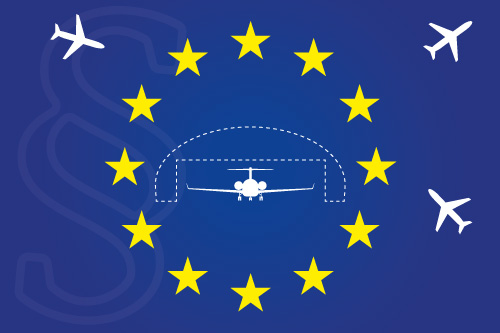Temporary Admission: what is the limit for multiple continuous stays at the same place?
Contents

This survey should be seen in connection with survey no. 7 about the period of stay.
The survey was made before Brexit in 2020, which is why the UK, and the Isle of Man are included. The UK part is still relevant for aircraft flying to the UK under a UK Temporary Admission.
 It is a fundamental precondition for the Temporary Admission procedure that the aircraft has a fixed base outside the EU, but a frequently asked question subsists: which facts can indicate that the operator or aircraft has become resident/domiciled in an EU airport even though an official home base is established outside the EU? To answer this, we have commissioned another verification survey.
It is a fundamental precondition for the Temporary Admission procedure that the aircraft has a fixed base outside the EU, but a frequently asked question subsists: which facts can indicate that the operator or aircraft has become resident/domiciled in an EU airport even though an official home base is established outside the EU? To answer this, we have commissioned another verification survey.
The replies from the different EU member states are based on the following case description
An aircraft is owned by a non-EU SPV and has a US (N) aircraft registration. The UBO (non-EU passport holder) quite often stays at an owned house within an EU member state and has organized a local hangar for an unlimited period. Yet, the UBO does not have habitual residence within the EU. The aircraft has been flying in and out of the EU every month regularly for the last year but always returns locally after each flight.

We often hear about the UK 180-day rule, which claims that an aircraft can, at a maximum, stay 180 days in the UK within a year. Even though we received a statement from HMRC (UK customs) confirming the interpretation of the six-month period mentioned in survey 7, this 180-day rumor persists. However, this rule has no foundation in the EU legislation. The 180-day rule might be meant to accommodate aircraft that often visit the UK with the Temporary Admission procedure and does not accommodate aircraft with a fixed UK base. We do not have knowledge of the 180-day rule in other EU member states. Regardless, everyone should be careful overstaying at the same airport or EU member state.
The result
The feedback is unanimous; the mentioned aircraft can no longer stay in the EU member states using the Temporary Admission procedure. A future stay will require a full importation. The result shows that different facts can indicate that the operator or aircraft has become resident or domiciled. The important question is: where does the aircraft spend most of its time, or whereto does it have a special connection? The setup used establishes the operator or aircraft as locals, which can also happen even with shorter stays than six months.
What to look for?
We have listed some indicators which can be used to detect such situations. A frequently visited EU destination could be considered a fixed base and be seen as to where the aircraft actually lives or has a special connection – if the EU destination is:
- Where the aircraft often starts or ends a trip
- Where the aircraft is parked when not used
- Where the aircraft spends most ground time
- Where hangar/parking has been organized on a more or less permanent basis
- Where the crew lives while on duty, operating the aircraft
- Where maintenance is done
- Where all spares are sent
- Where the aircraft documentation is stored
- Where the UBO has a seasonal home (if private aircraft or aircraft used primarily for the UBO)
- Where the UBO lives on a more or less regular basis (if private aircraft or aircraft used primarily for the UBO)
Each case needs to be looked at individually. One or more of the above indicators does not necessarily mean that the aircraft is considered to have a fixed EU base. Not having a resident or domiciled behavior can easily eliminate many of the abovementioned points. We believe that if the aircraft behaves as resident or domiciled in the EU, it must be fully imported.
Figure 1: Corporate aircraft using Temporary Admission (TA) in various EU member states
How will local customs authorities judge the mentioned case?
| Questions | DK | DE | UK | IM | IE | NL | FR | IT | ES | PT | GR |
|---|---|---|---|---|---|---|---|---|---|---|---|
| A: Will the local customs authorities allow continuous use of the TA procedure? | No | No | No | No | No | No | No | No | No | No | No |
| B: Will the local customs authorities see this behavior as a circumvention of the TA procedure and eventually deem a full importation, hence demand payment of VAT and customs duty since the aircraft actual lives locally in the EU on a more or less permanent basis? | Yes | Yes | Yes | Yes | Yes | Yes | Yes | Yes | Yes | Yes | Yes |
| The results are based on answers from international consulting firms in the respective countries. | |||||||||||
| Short & Sweet mail no. 9 | Part 1: Using TA – what is the Supporting Document, and how do you use it? |
| Short & Sweet mail no. 11 | Part 2: Using TA – what do customs look for during a ramp check, and why? |
| Short & Sweet mail no. 14 | Part 3: Using TA – in which scenarios will an operator need help or guidance? |
| Short & Sweet mail no. 21 | Part 4: Using TA – how do you prepare to handle a customs ramp check? |
Important things to know about Temporary Admission
Operators should be aware that different interpretations of the TA procedure exist between member states. Thus, it is important to have a competent customs agency outline the correct use and understanding based on the specific setup. The problem with local interpretations is often related to flights within France, Spain, Portugal, Italy, Greece, and less often other places. Click here to see a list of the known grey zone areas where different interpretations of the TA procedure exist and where an operator often needs guidance to use TA safely. None of the grey zone areas create problems for using TA if correctly handled and documented.
How can we help?
If you have questions about the above, please do not hesitate to contact us.
